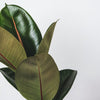Polyscias aka shade for minimalism in your interior

Polyscias is a genus of evergreen plants belonging to the Araliaceae family. Plants of this species are native to the tropical regions of Asia and Australia, but today they are cultivated all over the world as ornamental plants. In this article, we will take a closer look at the properties of this plant, how to grow it and what are its uses.
Polyscias is a very decorative plant that can reach a height of 2-3 meters. Its leaves are large, usually dark green and have a characteristic shape with sharp pointed ends. The flowers are inconspicuous and form spherical inflorescences. Plants of this species can have different shapes and sizes, depending on the species and cultivar. The genus Polyscias includes dozens of plant species, but the most famous species that you can see more often in stores include Polyscias frutisoca or Polyscias Hawaiana Ming or Polyscias Fabian .
Polyscias also got the name " Nutmeg tree ", mainly because its leaves, especially when wet, smell like nutmeg.
Polyscias is a great choice for lovers of minimalism
Polyscias plants are popular in gardens and interiors for their exotic and decorative appearance. Due to their shape and size, they are ideal for creating green walls and hedges, but only in climates where it is still warm. In our conditions, they are used as ornamental plants in the interiors of homes and offices, where they add a pleasant atmosphere and a tropical touch from Asia, where we find them most often. Due to its robust appearance with small leaves, it forms a lively design element that goes well with design spaces, especially with a nice flower pot.
How to care for Polyscias?
Polyscias are not among the plants that require a lot of care, despite that you need to be careful about a few things.
Light conditions
Polyscias grows best in semi-shaded habitat. Although it is called "shade plant" and it may give you the feeling that it will grow in the shadiest corner of your apartment, unfortunately it is not. It can be placed near a window facing south or east, but avoid direct sunlight, which could burn the leaves. On the contrary, a lack of light can lead to thinning of the crown, as Polyscias prefers bright environments .
Dressing
Polyscias needs regular watering. The soil should not be too dry, but not too wet either. In the summer months, watering once a week is recommended, and in winter, one watering every two weeks is sufficient. It is important to maintain the consistency of the dressing to avoid overwatering the soil, which could cause root rot. It is usually a good idea to change the substrate when you buy the plant for a higher quality substrate after the plant has acclimatized, which will not dry out so quickly, but will also not cause waterlogging in the event of overwatering. It pays to make sufficiently deep drainage under the plant, e.g. from expanded clay, which you can leave completely in the water so that the water cannot soak into the soil, but at the same time the moisture that will evaporate from it will continuously moisten the substrate.
Substrate and soil requirements
Polyscias prefers slightly acidic and well-drained soil. It is ideal to use a substrate mixture for green plants or palm trees with a high humus content. Don't forget to change the soil for the plant from time to time, for large plants we recommend about once every 2 years or to change the top part of the soil.
Temperature, air humidity and plant location
Polyscias prefers a temperature in the range of 18-24°C, with a minimum temperature of 16°C. He hates sudden temperature changes. Air humidity should be moderate, but in a dry environment the brush mite can appear. To increase the air humidity, a bowl of water or a humidifier can be placed around the plant. The plant will love you for regular dewing, which is suitable for example every week.
Polyscias plants can be placed indoors with good air circulation (ventilation and air conditioning), but not near drafts and cold air that can damage the leaves. Polyscias generally does not like cold drafts, so autumn and spring are especially critical for it, when there are cold days and the plant is near windows.
Reproduction
Polyscias are well propagated by cuttings or seeds. The best time for cuttings is in spring or late summer. Cuttings are taken from the lower part of the plant, 8-10 cm long stems are cut off and left to root in water. Stems that are too thin can rot, choose twigs that are stiffer.
The seeds of polyscias reproduce very poorly, because they usually do not bloom in our conditions.

Photo: Polyscias Hawaiiana Ming
The most popular Polyscias fruticosa
Polyscias fruticosa Hawaiiana Ming has a typical appearance consisting of small, compact and bushy twigs that can grow up to 1.5 meters in height. The leaves of this plant are compound and have several leaves that branch from the stem. These leaves have an attractive dark green color with slightly wavy edges.
The plant is also known for its climatic benefits. This type of plant has the ability to clean the air of impurities and toxic substances, which is useful for improving the air quality in closed environments and has a slight nutmeg smell.
The plant is planted in well-drained soil and prefers a slightly acidic environment. It requires enough light, but direct sunlight can burn the leaves, so it is advisable to place the plant in a semi-shaded place. Watering should be regular, but lack of water or waterlogging of the soil can cause damage to the plant's roots.
The most common problem with this plant is the yellowing and rotting of the leaves, which lead to falling off and the plant eventually turns pale and dies. This is the case if the watering is bad or the plant is exposed to a draft. Do not forget to treat the plant withquality fertilizer , ideally every 14 days during the growing season, in the winter months you can replace the fertilizer with lignohumate .

Photo: Polyscias scutellaria Fabian
Dark Polyscias Fabian
Polyscias scutellaria Fabian is an evergreen plant with beautiful, dark green leaves that gradually darken to a dark green, almost burgundy color. Its round leaves are gently wavy at the edges and have a slightly shiny surface, which gives the plant a special character. Because the plant is so dark, unlike other species, it may not have as much light, so we can put it further away from the windows, but remember that no plant will grow in the dark.
Polyscias Fabian also requires regular watering, but it is not advisable to overwater it. The plant also likes slightly acidic soil pH, so it may be appropriate to grow it in a substrate that is designed for acidic plants.

Photo: Detail of a leaf of a small Polyscias Fabian
Author: Martin Seidl
-
Posted in
Péče o pokojovky




